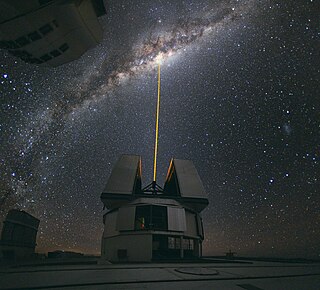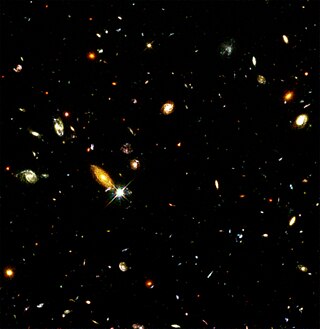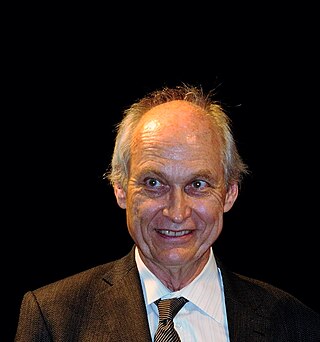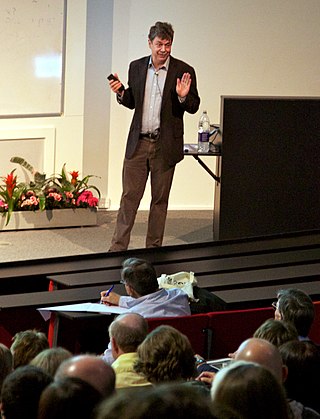Related Research Articles

The following outline is provided as an overview and topical guide to space science:

Extragalactic astronomy is the branch of astronomy concerned with objects outside the Milky Way galaxy. In other words, it is the study of all astronomical objects which are not covered by galactic astronomy.

Astronomy is a natural science that studies celestial objects and the phenomena that occur in the cosmos. It uses mathematics, physics, and chemistry in order to explain their origin and their overall evolution. Objects of interest include planets, moons, stars, nebulae, galaxies, meteoroids, asteroids, and comets. Relevant phenomena include supernova explosions, gamma ray bursts, quasars, blazars, pulsars, and cosmic microwave background radiation. More generally, astronomy studies everything that originates beyond Earth's atmosphere. Cosmology is a branch of astronomy that studies the universe as a whole.

Sandra Moore Faber is an American astrophysicist known for her research on the evolution of galaxies. She is the University Professor of Astronomy and Astrophysics at the University of California, Santa Cruz, and works at the Lick Observatory. She has made discoveries linking the brightness of galaxies to the speed of stars within them and was the co-discoverer of the Faber–Jackson relation. Faber was also instrumental in designing the Keck telescopes in Hawaii.

Michael S. Turner is an American theoretical cosmologist who coined the term dark energy in 1998. He is the Rauner Distinguished Service Professor Emeritus of Physics at the University of Chicago, having previously served as the Bruce V. & Diana M. Rauner Distinguished Service Professor, and as the assistant director for Mathematical and Physical Sciences for the US National Science Foundation.
Marc Davis is an American professor of astronomy and physics at the University of California, Berkeley. Davis received his bachelor's degree from the Massachusetts Institute of Technology in 1969, his Ph.D from Princeton University in 1973 and has been elected to both the National Academy of Sciences (1991) and the American Academy of Arts and Sciences (1992). He taught for a year at Princeton, 1973–74, then was on the astronomy faculty at Harvard from 1975 to 1981. Since 1981, he has been on the faculty of the Department of Astronomy and Physics at the University of California at Berkeley.

Simon David Manton White, FRS, is a British-German astrophysicist. He was one of directors at the Max Planck Institute for Astrophysics before his retirement in late 2019.
The Virgo Consortium was founded in 1994 for Cosmological Supercomputer Simulations in response to the UK's High Performance Computing Initiative. Virgo developed rapidly into an international collaboration between a dozen scientists in the UK, Germany, Netherlands, Canada, United States and Japan.
Hugh Couchman is a Canadian astronomer and professor at McMaster University. He is a computational astrophysicist who studies the growth of structure in the universe via gravitational N-body simulations.
Caleb Asa Scharf is a British-American astronomer and popular science author. He is currently the senior scientist for astrobiology at the NASA Ames Research Center in Mountain View, California. He formerly served as the director of the multidisciplinary Columbia Astrobiology Center at Columbia University, New York.

Adam Frank is an American physicist, astronomer, and writer. His scientific research has focused on computational astrophysics with an emphasis on star formation and late stages of stellar evolution. His work includes studies of exoplanet atmospheres and astrobiology. The latter include studies of the generic response of planets to the evolution of energy-intensive civilizations (exo-civilizations).

Computational astrophysics refers to the methods and computing tools developed and used in astrophysics research. Like computational chemistry or computational physics, it is both a specific branch of theoretical astrophysics and an interdisciplinary field relying on computer science, mathematics, and wider physics. Computational astrophysics is most often studied through an applied mathematics or astrophysics programme at PhD level.

The Illustris project is an ongoing series of astrophysical simulations run by an international collaboration of scientists. The aim is to study the processes of galaxy formation and evolution in the universe with a comprehensive physical model. Early results were described in a number of publications following widespread press coverage. The project publicly released all data produced by the simulations in April, 2015. Key developers of the Illustris simulation have been Volker Springel and Mark Vogelsberger. The Illustris simulation framework and galaxy formation model has been used for a wide range of spin-off projects, starting with Auriga and IllustrisTNG followed by Thesan (2021), MillenniumTNG (2022) and TNG-Cluster (2023).
Edmund Bertschinger is an American theoretical astrophysicist and cosmologist and professor of physics at MIT.
Aomawa L. Shields is an associate professor of physics and astronomy at UC Irvine. Her research is focused on exploring the climate and habitability of small exoplanets, using data from observatories including NASA's Kepler spacecraft. Shields was a 2015 TED Fellow, and is active in science communication and outreach. She develops interactive workshops to encourage self-esteem and teach about astronomy, combines her training in theater and her career in astronomy.

The University of Washington Planetarium is an active planetarium located in the Physics/Astronomy Auditorium on the University of Washington campus in Seattle, WA. The dome is 30 feet in diameter and utilizes six digital projectors to create an interactive display using the Worldwide Telescope planetarium software.
Risa H. Wechsler is an American cosmological physicist, Professor of Physics at Stanford University, and Professor of Particle Physics and Astrophysics at SLAC National Accelerator Laboratory. She is the director of the Kavli Institute for Particle Astrophysics and Cosmology.
Juna Kollmeier is an astrophysicist from the US. She is currently employed at the Carnegie Institution for Science and is the director of the fifth phase of the Sloan Digital Sky Survey, which made its first observations in October, 2020. She served as the director of the Canadian Institute for Theoretical Astrophysics, located at the University of Toronto, from 2021 to 2024.

The UniverseMachine is a project carrying out astrophysical supercomputer simulations of various models of possible universes, created by astronomer Peter Behroozi and his research team at the Steward Observatory and the University of Arizona. Numerous universes with different physical characteristics may be simulated in order to develop insights into the possible beginning and evolution of our universe. A major objective is to better understand the role of dark matter in the development of the universe. According to Behroozi, "On the computer, we can create many different universes and compare them to the actual one, and that lets us infer which rules lead to the one we see."
Barbara Sue Ryden is an American astrophysicist who is a Professor of Astronomy at Ohio State University. Her research considers the formation, shape and structure of galaxies. She was elected a fellow of the American Association for the Advancement of Science in 2016.
References
- 1 2 "Tom Quinn's Home Page". www-hpcc.astro.washington.edu. Retrieved 2017-04-12.
- 1 2 3 "Quinn, Tom – Department of Astronomy". depts.washington.edu. Retrieved 2017-04-12.
- 1 2 Menon, Harshitha (2015). "Adaptive Techniques for Clustered N-Body Cosmological Simulations". Computational Astrophysics and Cosmology. 2: 1. arXiv: 1409.1929 . Bibcode:2015ComAC...2....1M. doi: 10.1186/s40668-015-0007-9 . S2CID 10415395.
- ↑ "Faculty Friday: Tom Quinn | The Whole U". www.washington.edu. 4 February 2016. Retrieved 2017-04-12.
- 1 2 "Faculty | Astrobiology". depts.washington.edu. Retrieved 2017-04-12.
- ↑ "Tom Quinn". eScience Institute. Retrieved 2017-04-12.